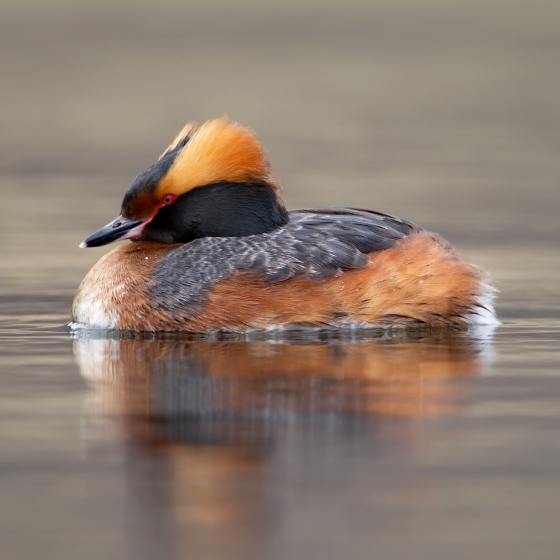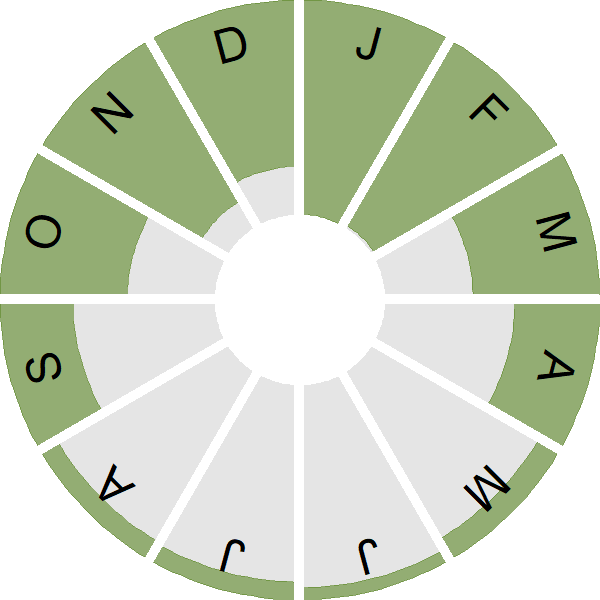Slavonian Grebe

Introduction
As with most grebe species, Slavonian Grebes look very different in their summer and winter plumages and choose different habitats in the two seasons.
The story of changing status of Slavonian Grebes in Britain differs between the seasons too. In winter individuals occur close inshore around the coasts of Britain & Ireland, with particular concentrations in sheltered Scottish waters, and south along the North Sea coast of eastern England. Atlas data show a significant expansion in the wintering range of recent decades.
The British breeding population is restricted to a few lochs in the eastern highlands of Scotland, where strikingly chestnut birds – with black head and prominent orange-yellow 'ear' tufts – can be glimpsed amongst emergent vegetation. Unfortunately, this tiny population is declining.

Key Stats
Identification
ID Videos
This section features BTO training videos headlining this species, or featuring it as a potential confusion species.
Winter Grebes
Small Breeding Grebes
Status and Trends
Conservation Status
Population Change
Small numbers of Slavonian Grebe breed in Scotland, with a five-year mean of 29 breeding pairs during the period 2015–2019, according to RBBP figures; the Scottish population has declined strongly in the 25 years to 2019 (Eaton et al. 2021) after rising from 49 pairs in 1971 to 73 pairs in 1993 (Balmer et al. 2013). Range losses have occurred across much of Europe and also in North America and the species is consequently listed as Vulnerable on the Global IUCN Red List (BirdLife International 2021).
Distribution
In winter, Slavonian Grebes occur around much of the coast of Scotland, with particular concentrations in sheltered waters in the Northern Isles, northwest Scotland, the Moray Firth, the Firth of Forth and Loch Ryan. In England they are found mainly in Northumberland and farther south along the coast from East Anglia to Cornwall. There are scattered records around the Irish coastline. A small breeding population is confined to the eastern Scottish Highlands.
Occupied 10-km squares in UK
2007/08–10/11
or view it on Bird Atlas Mapstore.
2008–11
or view it on Bird Atlas Mapstore.
European Distribution Map
Distribution Change
Change in occupied 10-km squares in the UK
from 1981–84 to 2007–11
or view it on Bird Atlas Mapstore.
from 1968–72 to 2008–11
or view it on Bird Atlas Mapstore.
Seasonality
Slavonian Grebes are most often see in winter, when present from early autumn to late winter/early spring, but also present in the small Scottish breeding range throughout summer.
Weekly pattern of occurrence
The graph shows when the species is present in the UK, with taller bars indicating a higher likelihood of encountering the species in appropriate regions and habitats.

Movement
Britain & Ireland movement
Foreign locations of birds ringed or recovered in Britain & Ireland
Dots show the foreign destinations of birds ringed in Britain & Ireland, and the origins of birds ringed overseas that were subsequently recaptured, resighted or found dead in Britain & Ireland. Dot colours indicate the time of year that the species was present at the location.
- Winter (Nov-Feb)
- Spring (Mar-Apr)
- Summer (May-Jul)
- Autumn (Aug-Oct)

European movements
EuroBirdPortal uses birdwatcher's records, such as those logged in BirdTrack to map the flows of birds as they arrive and depart Europe. See maps for this species here.
The Eurasian-African Migration Atlas shows movements of individual birds ringed or recovered in Europe. See maps for this species here.
Biology
Productivity and Nesting
Nesting timing
Egg measurements
Clutch Size
Survival and Longevity
Survival is shown as the proportion of birds surviving from one year to the next and is derived from bird ringing data. It can also be used to estimate how long birds typically live.
View number ringed each year in the Online Ringing Report.
Lifespan
Biometrics
Wing length and body weights are from live birds (source).
Ring Size
Classification, names and codes
Classification and Codes
- Order: Podicipediformes
- Family: Podicipedidae
- Scientific name: Podiceps auritus
- Authority: Linnaeus, 1758
- BTO 2-letter code: SZ
- BTO 5-letter code: SLAGR
- Euring code number: 110
Alternate species names
- Catalan: cabussó orellut
- Czech: potápka žlutorohá
- Danish: Nordisk Lappedykker
- Dutch: Kuifduiker
- Estonian: sarvikpütt
- Finnish: mustakurkku-uikku
- French: Grèbe esclavon
- Gaelic: Gobhlachan-mara
- German: Ohrentaucher
- Hungarian: füles vöcsök
- Icelandic: Flórgoði
- Irish: Foitheach Cluasach
- Italian: Svasso cornuto
- Latvian: ragainais dukuris
- Lithuanian: raguotasis kragas
- Norwegian: Horndykker
- Polish: perkoz rogaty
- Portuguese: mergulhão-de-penachos
- Slovak: potápka ušatá
- Slovenian: zlatouhi ponirek
- Spanish: Zampullín cuellirrojo
- Swedish: svarthakedopping
- Welsh: Gwyach Gorniog
Research
Causes of Change and Solutions
Causes of change
Ewing et al. (2013) did not find any clear evidence linking population declines to climate change but were also unable to discount the possibility that it could occur through indirect mechanisms that they could not consider. In a Scottish study, productivity was affected by a number of factors including predation of eggs by crows, predation of young by pike and disturbance by anglers (Summers et al. 2009). A study at Loch Ruthven found that breeding productivity was positively correlated with chironomid abundance at the site (Brooks et al. 2012). There is no clear evidence to indicate which of these factors (if any) is most likely to have driven population changes.
Publications (1)
Behavioural responses of non-breeding waterbirds to marine traffic in the near-shore environment
Author: Jarrett, D., Calladine, J., Cook, A.S.C.P., Upton, A., Williams, J.,Williams, S., Wilson, J.M., Wilson, M.W., Woodward, I. & Humphreys, E.M.
Published: 2022
Marine traffic is increasing globally, but there has been little research investigating the impact of this disturbance, particularly for non-breeding populations in near-shore environments. This study observed the behaviour of 11 seabird species in response to winter ferry passage around Orkney, increasing the evidence base available to inform impact assessments, planning and policy in the marine environment.
02.09.22
Papers

More Evidence
More evidence from Conservation Evidence.com
Partners
Citing BirdFacts
If you wish to cite particular content in this page (e.g. a specific value) it is best to use the original sources as linked in the page. For a more general citation of the whole page please use: BTO (20XX) BirdFacts Species: profiles of birds occurring in the United Kingdom. BTO, Thetford (www.bto.org/birdfacts, accessed on xx/xx/xxxx).

